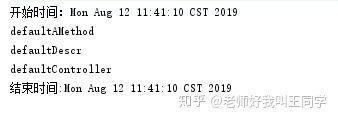这可能是最简单实现自定义注解的文章了
注解通过@interface定义
public @interface Log { } 复制代码 它的关键字和接口定义方式差不多,只不过前面多了一个@符号
注解的应用
注解的应用方式很简单在类或者方法的上方加一@xx就好了,具体的后面讲
public class Controller { @Log public void test(){ } } @Log public class Controller { public void test(){ } } 复制代码 元注解
元注解:就是定义注解的注解,是一种基本的注解可以定义到注解上的注解
@Retention
用来说明注解的生命周期
@Retention(RetentionPolicy.SOURCE) 注解只在源码阶段保留,编译期就被丢弃了
@Retention(RetentionPolicy.CLASS) 默认策略,注解只被保留到编译进行的时候,它并不会被加载到 JVM 中。
@Retention(RetentionPolicy.RUNTIME) 注解可以保留到程序运行的时候,它会被加载进入到 JVM 中,所以程序运行时也可以获取到它。
@Documented
Documented注解表明这个注释是由 javadoc记录的,在默认情况下也有类似的记录工具。 如果一个类型声明被注释了文档化,它的注释成为公共API的一部分。
@Target说明注解的作用目标
@Target(ElementType.TYPE) 接口、类、枚举、注解
@Target(ElementType.FIELD) 字段、枚举的常量
@Target(ElementType.METHOD) 方法
@Target(ElementType.PARAMETER) 方法参数
@Target(ElementType.CONSTRUCTOR) 构造函数
@Target(ElementType.LOCAL_VARIABLE) 局部变量
@Target(ElementType.ANNOTATION_TYPE) 注解
@Target(ElementType.PACKAGE) 包
@Inherited
@Inherited:如果一个使用了此注解的注解1,被一个class使用,那么这个注解1也对class的子类生效。例如:
@Inherited @Target(ElementType.METHOD) public @interface Log { } @Log public class testA(){} public class testB() extends testA{} 复制代码 testA应用了@Log这个注解,那么testB这个类上面也有@Log这个注解。
@Repeatable
例如:
@Target(ElementType.METHOD) @Retention(RetentionPolicy.RUNTIME) public @interface Logs { Log[] value(); } @Repeatable(Logs.class) public @interface Log{ String descr() default ""; } public class Controller { @Log(descr="描述1") @Log(descr="描述2") public void test(){ } } public class LogRunner { public static void main(String []args) throws Exception{ System.out.println("开始时间:"+new Date()); Class classs=Controller.class; Method[] ms=classs.getMethods(); for(Method method:ms){ boolean flag=method.isAnnotationPresent(Logs.class); if(flag){ Logs logs=method.getAnnotation(Logs.class); for(Log log:logs.value()){ System.out.println(log.descr()); } } } } } 复制代码 输出的时候就会输出,描述1,描述2.
实现自定义注解
第一步先定义一个注解
@Retention(RetentionPolicy.RUNTIME) @Target(ElementType.METHOD) @Documented public @interface Log { String methodName() default "defaultAMethod"; String controller() default "defaultController"; String descr() default "defaultDescr"; } 复制代码 第二步应用这个注解
public class Controller { @Log public void test(){ System.out.println("结束时间:"+new Date()); } } 复制代码 第三步通过反射让这个注解起作用
public class LogRunner { public static void main(String []args) throws Exception{ System.out.println("开始时间:"+new Date()); Class classs=Controller.class; Method[] ms=classs.getMethods(); for(Method method:ms){ boolean flag=method.isAnnotationPresent(Log.class); if(flag){ Log log=method.getAnnotation(Log.class); System.out.println(log.methodName()); System.out.println(log.descr()); System.out.println(log.controller()); method.invoke(classs.newInstance(),null); } } } } 复制代码 输出

如果将第二步方法上面的注解不使用默认的value,将代码改成
public class Controller { @Log(methodName = "test",controller = "testController",descr = "测试") public void test(){ System.out.println("结束时间:"+new Date()); } } 复制代码 那么将会输出












![[HBLOG]公众号](https://www.liuhaihua.cn/img/qrcode_gzh.jpg)

